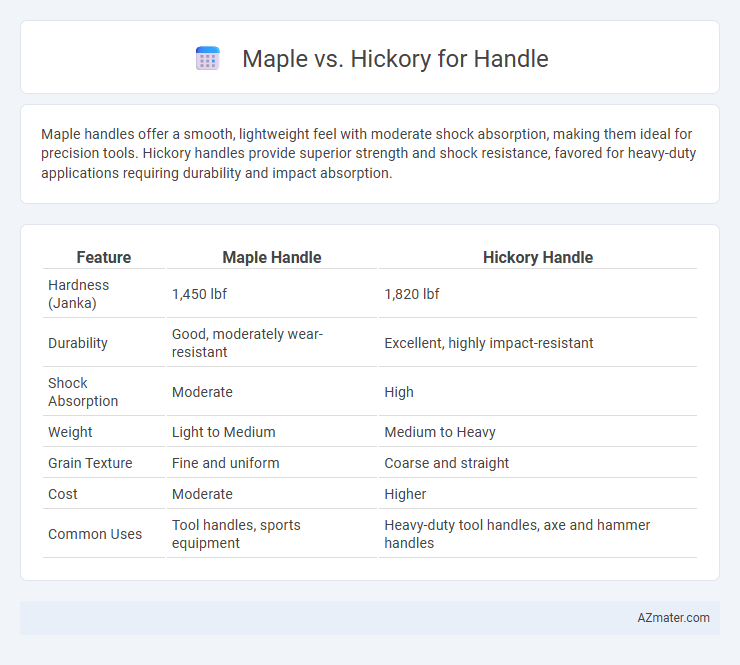Maple handles offer a smooth, lightweight feel with moderate shock absorption, making them ideal for precision tools. Hickory handles provide superior strength and shock resistance, favored for heavy-duty applications requiring durability and impact absorption.
Table of Comparison
| Feature | Maple Handle | Hickory Handle |
|---|---|---|
| Hardness (Janka) | 1,450 lbf | 1,820 lbf |
| Durability | Good, moderately wear-resistant | Excellent, highly impact-resistant |
| Shock Absorption | Moderate | High |
| Weight | Light to Medium | Medium to Heavy |
| Grain Texture | Fine and uniform | Coarse and straight |
| Cost | Moderate | Higher |
| Common Uses | Tool handles, sports equipment | Heavy-duty tool handles, axe and hammer handles |
Introduction to Maple and Hickory Handles
Maple handles are renowned for their smooth texture, durability, and resistance to impact, making them ideal for tools and sports equipment requiring precision and comfort. Hickory handles, distinguished by their exceptional strength, shock absorption, and flexibility, excel in demanding applications where resilience and toughness are critical. Both hardwoods provide ergonomic benefits, with maple favored for its fine grain and aesthetic appeal, while hickory is preferred for heavy-duty performance.
Wood Properties Comparison: Maple vs Hickory
Maple and hickory differ significantly in hardness and shock resistance, with hickory typically scoring higher on the Janka hardness scale, making it more durable for heavy-duty handles. Maple offers a smoother grain and lighter weight, providing comfort and precision in tool handling, while hickory's dense, fibrous structure delivers superior impact absorption and flexibility under stress. Both woods exhibit excellent workability and wear resistance, but hickory's natural resilience makes it the preferred choice for handles exposed to repeated strikes or heavy use.
Durability and Strength: Which Handle Lasts Longer?
Hickory handles are known for their superior durability and shock resistance, making them ideal for tools subjected to heavy impact and repeated use. Maple handles offer a hard, dense wood that is strong but less flexible, which can lead to a higher risk of cracking under intense pressure. For longevity and withstanding tough tasks, hickory generally lasts longer due to its natural combination of strength and elasticity.
Weight and Balance: Impact on Tool Performance
Maple handles are typically lighter than hickory, offering better control and reduced user fatigue during prolonged use. Hickory's denser composition provides enhanced balance and absorbs shock effectively, which improves tool stability and precision. Choosing between them depends on prioritizing lighter weight for agility (maple) or superior shock absorption and durability (hickory) for heavy-duty tasks.
Shock Absorption: Comfort During Use
Hickory is renowned for its superior shock absorption, making it a preferred choice for tool handles where comfort during prolonged use is critical. Maple, though hard and durable, offers less natural vibration dampening compared to hickory, which can result in increased user fatigue over time. The cellular structure of hickory fibers absorbs impact effectively, reducing hand strain and enhancing overall handling comfort in demanding tasks.
Resistance to Splitting and Cracking
Maple handles exhibit superior resistance to splitting and cracking due to their fine, dense grain structure, making them ideal for tools requiring durability under stress. Hickory, while also strong and shock-absorbent, has a coarser grain that can be more susceptible to splitting over time with heavy use. For longevity and structural integrity, maple is often preferred in applications demanding high resistance to mechanical wear and tear.
Cost Differences: Maple vs Hickory Handles
Maple handles generally cost less than hickory handles due to the more abundant availability and faster growth rate of maple trees. Hickory offers greater durability and shock resistance, which can justify its higher price despite the increased expense. Choosing between maple and hickory handles often depends on balancing budget considerations with the desired toughness and longevity.
Availability and Sourcing of Handle Woods
Maple handles are widely available due to the abundance of sugar maple and hard maple species in North America, making sourcing relatively easy and cost-effective. Hickory, native to the eastern United States, is highly sought after for its strength and shock resistance but can be less available and more expensive due to regional growth limitations and increased demand. Both woods are sustainably harvested, but maple generally offers a more consistent supply for handle manufacturing.
Best Applications for Maple and Hickory Handles
Maple handles offer superior hardness and smoothness, making them ideal for precision tools like chisels, measuring instruments, and sports equipment such as baseball bats. Hickory handles provide exceptional shock absorption and durability, perfect for heavy-duty applications including axes, hammers, and outdoor tools that require high impact resistance. Selecting maple suits tasks demanding fine control and aesthetics, while hickory excels in rugged, high-stress environments needing resilience and strength.
Final Recommendation: Choosing the Right Handle Material
Maple offers a smooth, dense grain that provides excellent shock absorption, making it ideal for tools requiring precision and comfort. Hickory is renowned for its superior strength, durability, and natural resistance to wear, preferred for heavy-duty applications demanding toughness. Select maple handles for ergonomic ease and finer control, while hickory is recommended for longevity and resilience in high-impact use.

Infographic: Maple vs Hickory for Handle
 azmater.com
azmater.com